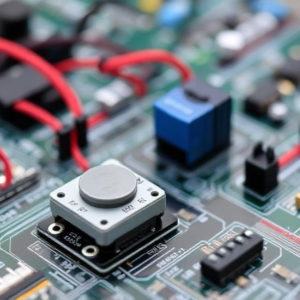What are Magnetic Sensors?
Magnetic sensors are devices that detect magnetic fields and convert that information into an electrical signal. Basically, they sense the presence or strength of a magnetic field and can be used in a variety of applications where magnets or magnetic fields play a role.

How Do Magnetic Sensors Work?
Magnetic sensors work by detecting changes in the magnetic field around them. The magnetic field can come from magnets, electric currents, or even the Earth’s magnetic field. When a magnetic field interacts with the sensor, it causes a change in the sensor’s output (like generating an electrical signal), which can then be used to measure the field or trigger a response.
Types of Magnetic Sensors
- Hall Effect Sensor:
- This is one of the most common types of magnetic sensors.
- The Hall Effect is a phenomenon where a magnetic field applied to a conductor creates a small voltage (called the Hall voltage) across the conductor.
- Hall sensors can detect the strength and direction of magnetic fields and are often used in devices like speedometers, brushless motors, and position sensors.
- For example, in cars, Hall sensors can measure the position of the wheels to track speed.
- Magnetoresistive Sensor:
- These sensors detect changes in the resistance of a material when exposed to a magnetic field.
- When a magnetic field is applied, it changes the resistance of the material, which can be measured and used to determine the strength or direction of the field.
- Magnetoresistive sensors are often used in applications where high accuracy is needed, like in compasses or hard disk drives.
- Inductive Sensor:
- These sensors work by detecting changes in the inductance of a coil when a magnetic object passes nearby.
- They are often used to detect metal objects or in proximity sensing (like in security systems or metal detectors).
- Reed Switch:
- A reed switch is a small, simple magnetic sensor made of two metal reeds inside a glass tube. When a magnet gets close, the reeds touch, completing a circuit.
- Reed switches are commonly used in door/window sensors in security systems, or for counting objects passing through a sensor.
Why Are Magnetic Sensors Useful?
- Measuring Position: Magnetic sensors are great for determining the position of objects. For example, they can tell you the position of the crankshaft in an engine or the opening of a door.
- Speed and Rotation: They can measure how fast something is moving or rotating. This is useful for things like speedometers in cars, motors, or even for monitoring wind speed in weather stations.
- Navigation: Magnetic sensors can detect Earth’s magnetic field to help with compass readings, guiding systems, or robot navigation.
- Detecting Magnetic Fields: These sensors help detect the presence and strength of magnetic fields, which is important in a wide range of technologies.
Where Are Magnetic Sensors Used?
- Automotive:
- Used in cars to measure wheel speed, crankshaft position, and even in anti-lock braking systems.
- Consumer Electronics:
- Magnetic sensors are found in devices like smartphones (for detecting orientation or proximity), computers (for hard disk drives), or smartwatches (for activity tracking).
- Healthcare:
- In MRI machines (Magnetic Resonance Imaging), magnetic sensors help create images of the inside of your body by detecting how your body interacts with strong magnetic fields.
- Security Systems:
- Reed switches in door/window sensors can detect if someone is trying to break in.
- Industrial Applications:
- Magnetic sensors help monitor machinery, detect the presence of objects, and provide safety mechanisms.
- Robotics:
- Robots use magnetic sensors to detect positions, movements, and interactions with their environment.
Pros of Magnetic Sensors
- Non-contact detection: Magnetic sensors can work without needing to physically touch the object they are sensing, which is useful in many applications.
- Durability: They are typically very durable and can work in harsh environments (extreme temperatures, dirty environments, etc.).
- Low power consumption: Many magnetic sensors use very little energy, making them ideal for battery-powered devices.
Cons of Magnetic Sensors
- Sensitivity to external interference: Sometimes, other magnetic fields or electrical noise can interfere with the sensor’s performance.
- Limited range: Depending on the type of magnetic sensor, the range at which it can detect magnetic fields may be limited.
Summary
Magnetic sensors are devices that detect the presence or strength of a magnetic field and turn that information into an electrical signal. They are used in many applications, like measuring speed, determining position, navigation, and more. The most common types include Hall Effect sensors, magnetoresistive sensors, reed switches, and inductive sensors. These sensors are found in everything from cars and electronics to security systems and industrial equipment.











